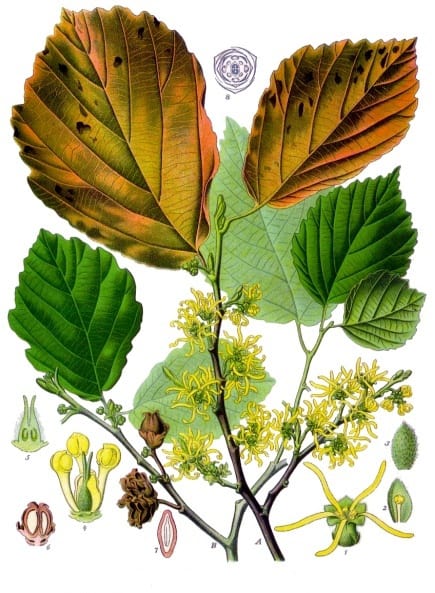Gardening for Health

Season of the Witch Hazel
By Maria Price
A walk in the woods in late fall may greet you with an inconspicuous beauty known as witch hazel. Halloween is our annual reminder that the “witches” are out. Even in my own garden I didn’t notice my witch hazel blooming until I was underneath it and a light sweet lemony aroma wafted over me. I looked up and saw my native witch hazel in bloom with its yellow fringe-like blossoms against its bright yellowing leaves.
Witch hazel (Hamamelis virginiana) is a deciduous shrub or small tree that can grow up to 15 feet. It can be found in woods from Nova Scotia to Florida. Witch hazel blooms for a few weeks in October and November. It seems to always be multi-stemmed with a reliable upright shape which makes it useful for a variety of settings in residential gardens. It is extremely long-lived, continually sending up new stems and can be maintained at any desired height between five and 14 feet by removing the older taller stems. It is extremely adaptable, in that it can grow in deep shade or full sun, in deep organic soil, clay or thin rocky soil. It tolerates prolonged droughts or periodic inundation. Try to select a seedling that drops its leaves before flowering for maximum flowering impact. Chinese witch hazels bloom in late winter or early spring.
Historically, witch hazel was used by Native Americans for a multitude of ailments. They drank a leaf tea for colds and sore throats. They used it for bloody dysentery, cholera, cough, asthma and for bruises and sore muscles.
Today, you can find some form of witch hazel in every pharmacy; the distilled extract is used in ointments as an astringent for piles, toning skin, suppressing profuse menstrual flow, and eye ailments. Tannins in the leaves and bark are thought to be responsible for its astringent and hemostatic properties. It is used commercially in preparations to treat hemorrhoids, skin irritations, minor pain and itching especially from insect bites. Preparation H and Tucks both contain witch hazel and are the commercial pharmaceutical product often recommended for hemorrhoids. It is the alcoholic tincture of the herb that is used this way and not witch hazel water.
Enjoy this season of the witch hazel and its magical beauty and uses.
